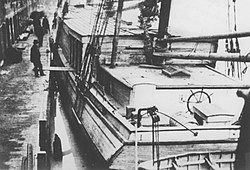Rouse Simmons
The legacy of the schooner lives on in the area, with frequent ghost sightings and tourist attractions whereby its final route is traced.
However, with railroads, highways, and tree farms proving much more economical, the tree-shipping industry was on a steep decline and by 1920 they stopped sailing.
The schooner was soon purchased by wealthy lumber magnate Charles H. Hackley of Muskegon, Michigan and joined his sizeable fleet.
August died in November 1898 aboard the S. Thal – a 52-ton, two-masted schooner – when it sank in a storm near Glencoe, Illinois.
[3][4] Schuenemann loaded the schooner with 5,500 trees from Thompson Harbor near Manistique, Michigan and planned to make the week-long journey to Chicago.
The difficult weather had discouraged his competitors from making their own journeys, and snow had covered the tree farms in Michigan and Wisconsin.
The conditions of the day were very poor, with many ships anchoring in port for shelter to avoid being battered by the 60-mile-per-hour (52 kn; 97 km/h) winds that could be anticipated in a November gale.
Two years earlier the schooner had been towed to port by The Grand Haven Tribune after it was found riding low in the water.
[5] When the Kewaunee Life Saving Station spotted the Rouse Simmons on 23 November 1912 it was low in the water with tattered sails, flying its flag at half mast to signal that it was in distress.
George E. Sogge of Two Rivers, located just south of Kewaunee, sent out the power boat Tuscarora on a rescue mission, but the Simmons was not seen again.
Bellrichard was searching for the Vernon, a 177-foot, 700-ton steamer that had sunk in a storm in October 1887, and had been told about an area in which local fishermen had frequently snagged their nets.
Several items recovered from the Rouse Simmons are now housed in Rogers Street Fishing Village Museum in Two Rivers, including the ship's wheel.


